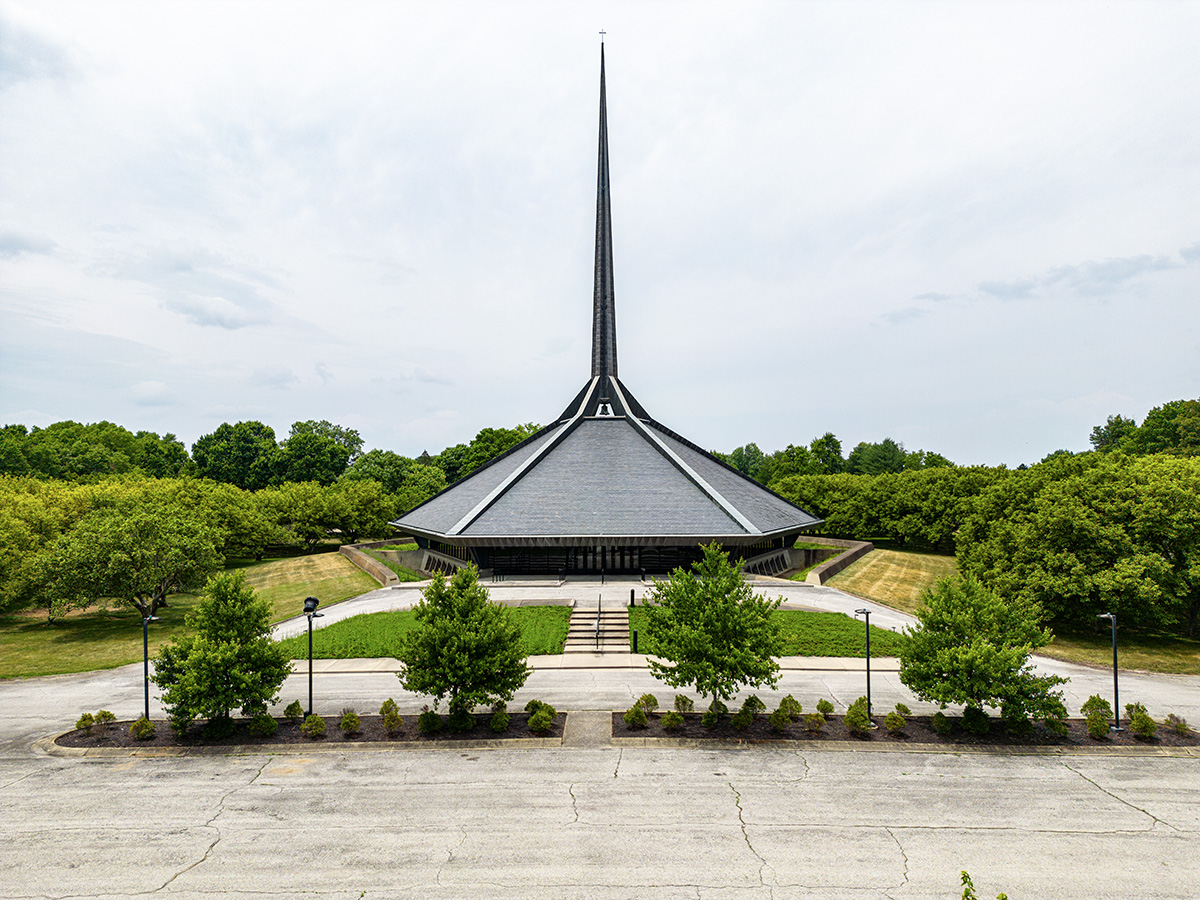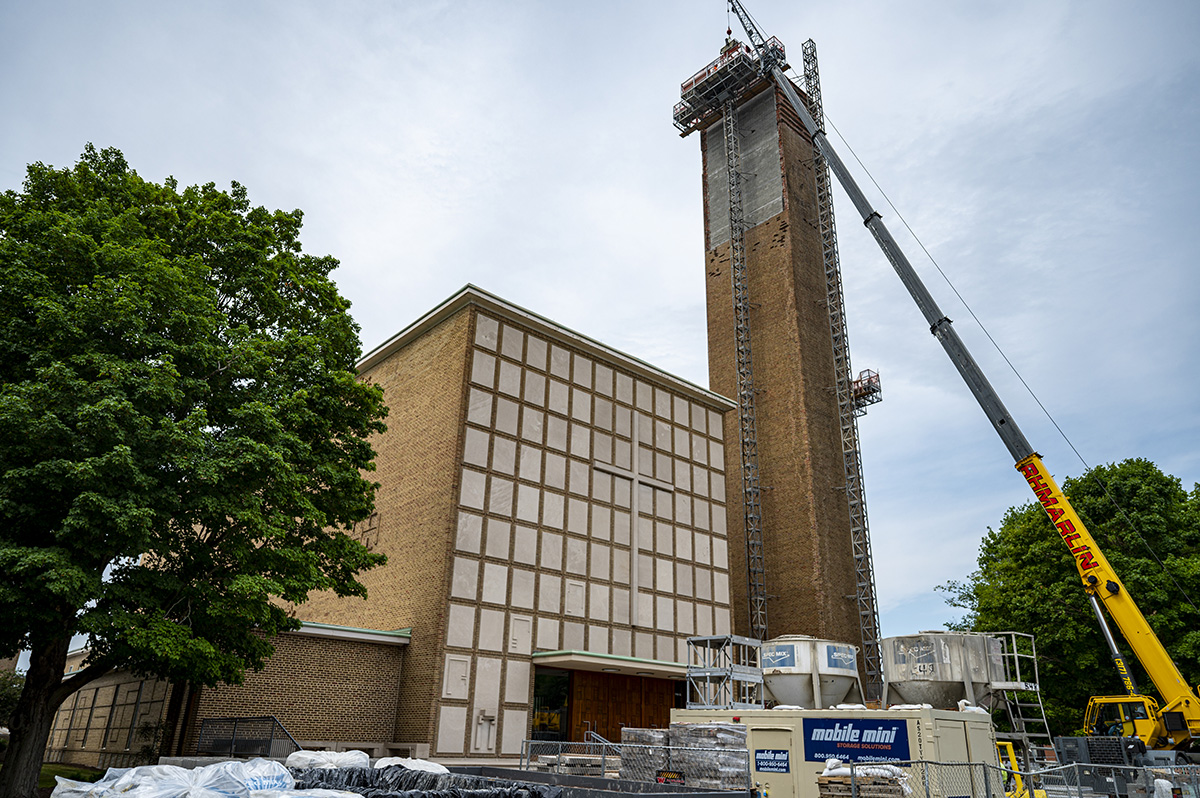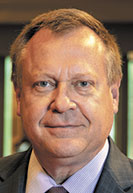Subscriber Benefit
As a subscriber you can listen to articles at work, in the car, or while you work out. Subscribe NowA quiet two-lane road intersecting the business district of many midsize Hoosier cities probably wouldn’t be expected to host anything more remarkable than a strip mall or a gas station.
And yet, here on Fifth Street in Columbus sits the Cleo Rogers Memorial Library, designed by I.M. Pei (whose other projects include the Louvre Pyramid in Paris and the Rock and Roll Hall of Fame in Cleveland). And across the street, facing the library’s expansive brick plaza, resides First Christian Church, one of the first modernist-style houses of worship built in the United States.
The aging Fifth Street structures aren’t Columbus’ only architectural gems. Far from it. As anyone remotely familiar with this city of roughly 50,000 residents already knows, it’s peppered with some 90 landmarks, from schools to fire stations to churches—most done in the spare, modernist style so popular in the mid-20th century. The American Institute of Architects ranks Columbus sixth in the nation for architectural innovation and design, after only Chicago, New York City, Boston, San Francisco and Washington, D.C.
But with great architectural heritage comes great responsibility. And the financial and logistical weight of that responsibility has grown of late. The newest of Columbus’ buildings were built in the 1970s, meaning some of the city’s notable landmarks need expensive repairs.
“Mid-century buildings face challenges with some of the materials they use and also environmental issues such as energy efficiency,” said Indiana Landmarks President Marsh Davis. “I’m not saying they all do, but it’s a common issue among buildings from the ’60s and ’70s. So how do we make them environmentally sustainable?”
Plus, some can no longer fulfill the functions for which they were designed, meaning they must somehow be repurposed. And all this heritage needs to be presented in a fresh, appealing way to Columbus’ residents, not all of whom are sold on the urgency of keeping a bunch of quirky old buildings in tiptop shape.
“The question of how regular, working-class residents of Columbus view this collection is something I’m asked about often and the one I struggle with the most,” said Erin Hawkins, director of marketing for the Columbus Area Visitors Center. “It would be disingenuous to say that this is a whole city of architecture lovers. There are people who don’t see the value. But it’s nevertheless a key part of our civic identity.”
Interestingly, even Columbus residents immune to the charms of their city’s modernist buildings might owe their livelihoods, in a roundabout way, to them.
A Hoosier jewel
The town became an architectural landmark thanks in large part to J. Irwin Miller, former chair and CEO of Columbus-based Cummins Inc. Miller, an aficionado of fine architecture, worried that Cummins might struggle to attract world-class engineering talent because of its unremarkable location. So he did something about it.
Miller wasn’t a fan of the cookie-cutter schools being thrown up all over the country to accommodate the influx of baby boomers, so in 1957 the charitable Cummins Foundation volunteered to pay the architect’s design fees for the planned Lillian Schmitt Elementary School—provided it was designed by a world-class, Cummins-approved architect. The building, still in use today, was done by famed Chicago designer Harry Weese.
Cummins expanded and formalized this concept in 1960 with its own Architecture Program. Initially, the Cummins Foundation made grants to hire high-quality architects (from its approved list) to build schools, but the roster of eligible structures was soon expanded to include all county facilities owned and operated by public tax dollars.
“I think they definitely said, ‘We think this is important. We think this makes our headquarters community unique,’” said Tracy Souza, president and CEO of the Heritage Fund Community Foundation of Bartholomew County, which (among other things) focuses on Columbus-area culture and architecture. “They needed to attract talent to this Midwestern town and not lose them to one of the great coastal cities of the United States. It was a way for Cummins to stay competitive for talent.”
It seems to have worked in spades.
Cummins is still based in Columbus, even though roughly 60% of its worldwide staff lives and works elsewhere. And the town’s architectural heritage attracts more than just new hires.
For instance, the Columbus Area Visitors Center (which is effectively Bartholomew County’s convention and visitor bureau) brings in some $200,000 annually by selling guided tours of the city’s landmarks.
About 70,000 people a year visit to see the buildings. And Columbus’ architecture helps attract a more rarified roster of conventions, including gatherings of the National Trust for Historic Preservation; an American Institute of Architects design conference; and the 2015 annual board meeting of Docomomo US (dedicated to the documentation and conservation of buildings, sites and neighborhoods of the modern movement).
Today, even Miller’s house and garden are a major tourist attraction. Built in 1957, the home is considered an icon of modern residential architecture on par with Frank Lloyd Wright’s Fallingwater.

Protecting the heritage
Clearly, when it comes to attracting international architectural attention, Columbus enjoys advantages other municipalities can only dream about. In 2015, the Heritage Fund created an organization to both look after and publicize the city’s assets—the Landmark Columbus Foundation.
“It’s an organization that was put together by a group of community leaders that was focused on shepherding the future of these iconic treasures,” said Rick Johnson, founding board chair of Landmark Columbus.
The seeds for the organization were planted a few years before by a relatively innocuous act—the Bartholomew County Public Library’s desire to make some minor (if it were any other building) repairs and alterations to the main entrance and plaza of Pei’s Cleo Rogers Memorial Library. This sort of thing is typically pretty routine stuff, but in this case it seemed akin, in some circles, to painting earrings on the Mona Lisa.
“It became a tangible example of one of the most significant buildings in town going through alterations without a set of guiding principles or values,” said Richard McCoy, executive director of the Landmark Columbus Foundation. “It was done with good intentions, but there wasn’t a process that allowed the community to understand it.”
The debate over the changes (which eventually produced a compromise satisfactory to all) inspired the local brain trust that tackled the issue to delineate two things the city desperately needed—a preservation group to take point on issues concerning the city’s notable buildings,and also a biennial celebration that would come to be called Exhibit Columbus. The first effort would preserve what the city already has. The latter would give those structures a higher profile by staging a once-every-two-years festival.
“I was hired through the redevelopment commission to come up with a strategy and a plan for the heritage of Columbus,” McCoy said. “It was set out without a lot of constraints and by working together with a lot of the city’s community leaders.”
One of the first challenges was fixing First Christian Church’s iconic tower. Its brick veneer had been crumbling for decades, and it needed to either be extensively repaired or demolished. The Heritage Fund, First Christian Church and Landmark Columbus worked together to raise the necessary $3.2 million. More than half of the funds came from out-of-county donors, with about a third of that from out-of-state donors, including the National Parks Service and the National Fund for Sacred Places.
That effort could serve as a template for raising funds for future restoration and maintenance projects. McCoy said that when you’re preserving nationally and internationally famous monuments, you can cast a much wider net for donations.
Repurposing
Raising money, however, might not be the biggest concern. Over time, buildings—no matter how attractive or significant—often become obsolete and unable to fulfill their original purpose. This has already happened several times in Columbus.
For instance, the Commons downtown mall, built in 1973 and featuring an enormous, world-famous kinetic artwork called Chaos 1, was largely torn down in 2008, with the massive Chaos 1 left in place while a new structure rose around it. Today, it’s owned by the city and serves as a community center and events space.
And the Irwin Union Bank and Trust building, constructed in 1961, was recently converted into a Lucabe Coffee Co. coffee shop. The drive-through dispenses to-go coffee instead of taking in deposits, and the vault was converted into a children’s play area.
Finally, The Republic newspaper office, a one-story building with immense windows that formerly housed the town’s newspaper, is home to the Indiana University J. Irwin Miller graduate architecture program.
But not every structure of architectural importance finds a new use so easily—or at all. Such was the case with the Columbus Occupational Health Association building, commonly known as COHA.
Owned by Cummins, the outpatient medical clinic’s open spaces and bright colors were a sharp departure from the drab medical facilities available when it opened in 1973. However, COHA operations moved to new quarters in 2016, and the building went up for sale. After years with no takers, it was demolished in 2020.
Although this wasn’t the preferred outcome, it also wasn’t an unmitigated disaster, according to Souza. Both she and McCoy say they want to avoid the perception that the city’s architectural trust is just a series of static structures celebrated for what they were rather than for the role they play in today’s Columbus.
“You want to preserve what’s important, and use it,” Souza said. “The building was a unique piece of architecture, and it served as a health center for Cummins employees for years. But the community couldn’t find another use for it after trying for many years. So it was taken down. And that’s not the end of the world. We want to pass on to the community the tools and the resources and the desire to continue to create a unique asset around design in this community. And if one building falls off the pile for the right reasons, so be it.”
Buildings that are “between users” may be purchased by the Columbus Capital Foundation, a part of the Heritage Fund. The not-for-profit holding company takes ownership of important properties and maintains them until a new owner is found. One of the organization’s current foundlings isn’t a masterpiece of modern architecture; it’s the Crump Theatre, an old downtown movie house in the Columbus Historic District. It hosts occasional city functions as it awaits a new incarnation.

Biggest challenge
Columbus Capital’s latest acquisition, however, is by far its most problematic.
In July 2022, the tiny congregation of North Christian Church held its final service before closing the building, arguably the most distinctive landmark in a city filled with distinctive landmarks. Like so many historic houses of worship across the country, there just weren’t enough worshippers to keep the doors open.
The church and its grounds have now passed to the Columbus Capital Foundation, which keeps the place in stasis as it looks for a buyer. Right now, the strongest contender is the Bartholomew County Public Library, which is considering turning the church into a “community hub” for performances, public meetings and other uses.
But there’s a problem. Or rather, problems.
As one can imagine, making a church look like anything other than a church is extremely difficult. Especially in the case of North Christian. The building is basically a shallow, six-sided shield surrounded by acres of expertly designed parkland and surmounted by a 192-foot spire.
It’s as much a symbol of Columbus as the Sydney Opera House is of Australia and Cinderella’s Castle is of Disney World. It’s also one of seven National Historic Landmarks in Columbus.
But how, exactly, does one turn a building such as this to secular uses? It’s easy to get rid of church billboards and choir robes and hymnals, but what about the beautifully understated, tile-floored baptistry, or the custom-made pipe organ in the sanctuary? Or the fact that not a single window in the building can be opened, meaning temperatures must be maintained by a vast, breathtakingly expensive, bespoke air-conditioning system in an underground bunker—which a couple of years ago broke down during the hottest part of summer?
Library officials are amid a protracted study to see whether it’s possible to convert the church into the sort of facility they need without utterly robbing it of context or destroying its unique qualities.
“I hope to have some kind of resolution by the end of this year or the beginning of next year,” said Jason Hatton, director of the Bartholomew County Public Library. “But that’s just the first step in a very long process. If we move forward, there are lots of other pieces that would have to come together.”
Finding the money
Although North Christian’s future is up in the air, one thing is certain. Renovations, repairs and maintenance of the building and grounds will require money. So much money.
“If we move forward, it will take a lot of dollars,” Hatton said. “As a public entity, we will have to supplement any public dollars with private dollars as well.”
Which would be where Landmark Columbus and other local entities enter the picture (though, in truth, they’ve been knee-deep in the North Christian Church drama for some time). Donors nationwide would be asked to save what The New York Times described as “Perhaps the most striking and impressive example of contemporary architecture in Columbus … .”
“I believe that Columbus has the wherewithal to take care of its legacy,” said Indiana Landmarks’ Davis. “Columbus made the choice to pursue excellence in design, and with that comes a degree of responsibility. What I admire about Columbus is the way they’re going about developing an appreciation for what they have.”
Hatton, for his part, understands the long, complex, perhaps frustrating journey he’ll be taking if the Bartholomew County Public Library takes on this famous structure. In meetings with other library directors, mentioning that one of his buildings was designed by I.M. Pei gives him a lot of street cred. As would taking responsibility for a National Historic Landmark.
“There is an awe there, but there’s also a realization of everything that comes with running a building like that,” he said. “But challenges aren’t bad, right? They just require us to be more thoughtful. And good design is just being thoughtful about what you’re doing.”
Speaking of thoughtfulness, McCoy has a lot on his plate these days besides North Christian Church. Landmark Columbus is working with the Bartholomew County School Corp. to develop review systems as they prepare a plan for wholesale updates to many of their buildings. And the Aug. 25-26 opening weekend for the next edition of Exhibit Columbus is fast approaching.
“What we do at our core is to educate people and advocate,” McCoy said. “Exhibit Columbus becomes a powerful tool for that, because it gets people engaged and shows how Cummins properties are active and interesting and part of our downtown. It gives people a connection with them.”
Hawkins, the visitors center marketing director, said tourism numbers have seen modest upticks most years, particularly since the establishment of Landmark Columbus. She also receives occasional queries from other towns about how they could develop something similar to what Columbus has. Her answer, couched in suitably diplomatic language, is that they can’t.
“Other communities sometimes call and say, ‘How did you do this here? Why did it work?’” Hawkins said. “Well, I think it was a perfect storm of having a very influential local business leader with a deep understanding of design and architecture, and the means and will to make something like this happen. I can’t imagine something like this ever coming together in that same way again.”•
CORRECTION: The original version of this story incorrectly identified the new use for the former Republic newspaper office in Columbus. It is now home to the Indiana University J.Irwin Miller Graduate Architecture program.
Please enable JavaScript to view this content.





As a student of Indiana University’s J. Irwin Miller Architecture program, I really appreciate this article. Columbus architecture is a treasure worthy of preservation and further, reinvigoration. I especially love what Lucabes coffee has done with the Irwin Union bank building. That being said, I offer a suggestion and a correction. There should be a shout out to Architect Louis Joyner for his dedication to Columbus architecture preservation and his current work on the clock tower. Also, the Republic building houses The Indiana University J.Irwin Miller Graduate Architecture program not Columbus Design Institute. Thanks!
Thanks for reading and for pointing out our error. We have corrected the story.